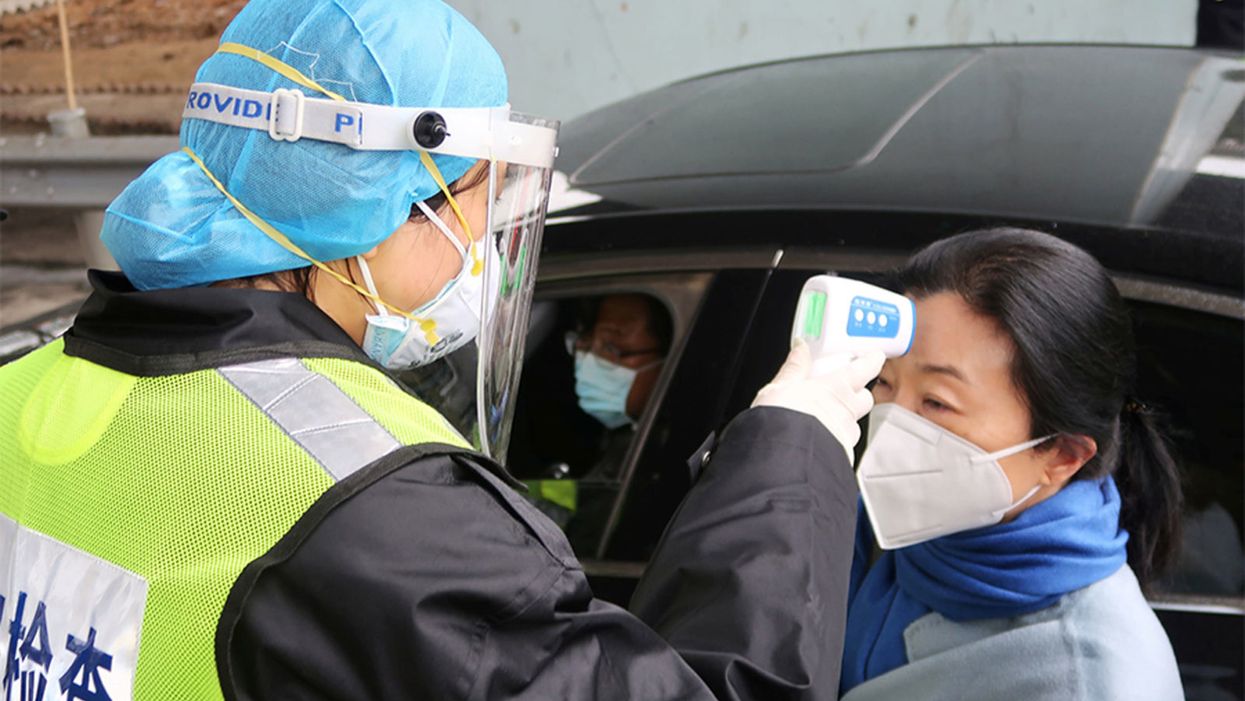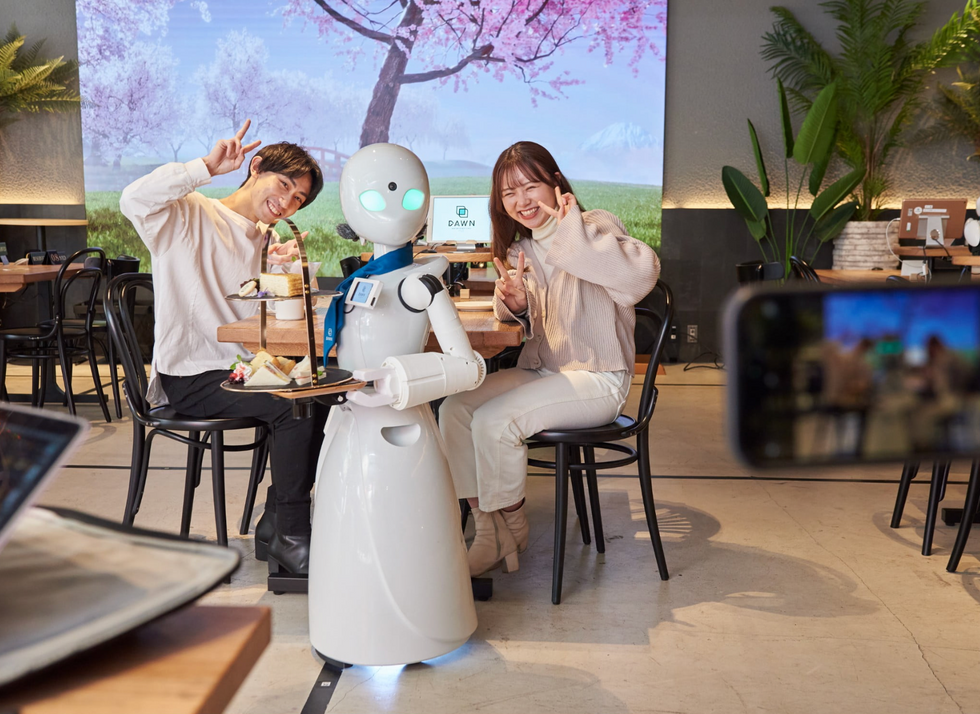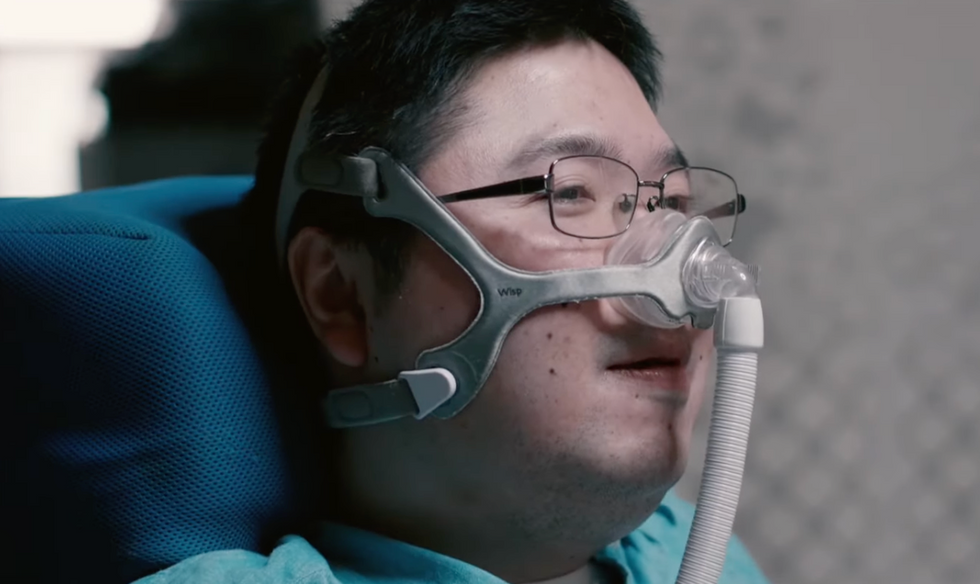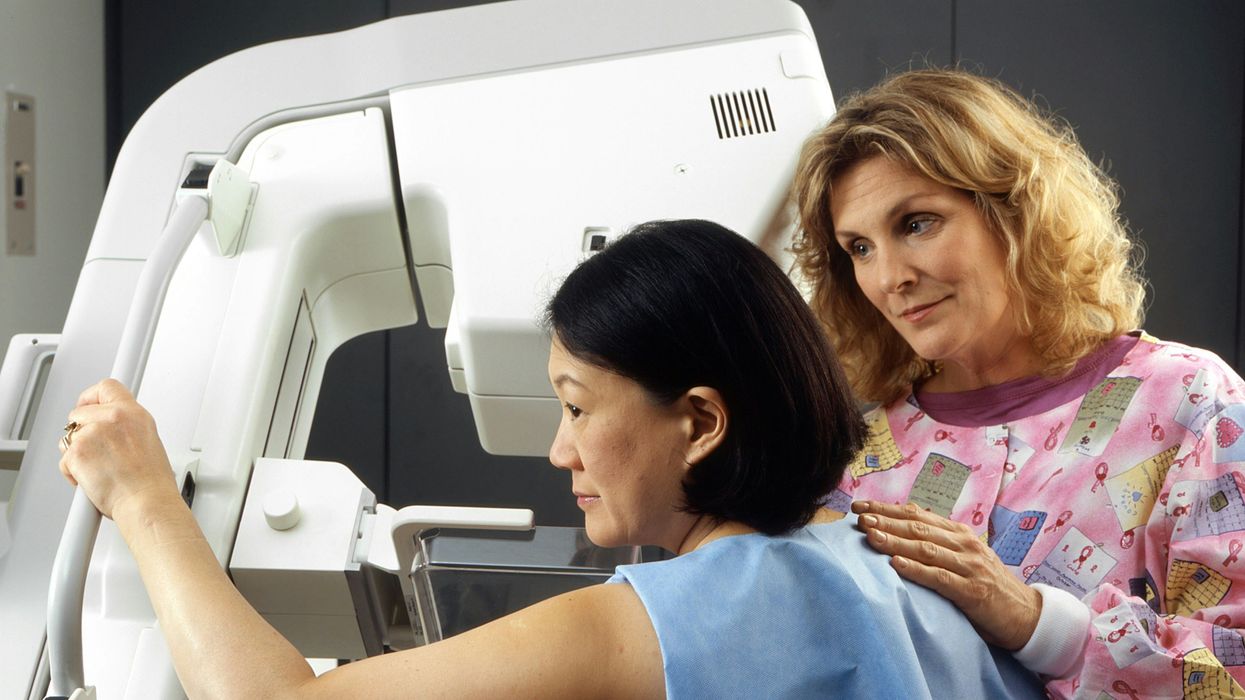How Emerging Technologies Can Help Us Fight the New Coronavirus

A security officer in a protective mask checks the temperature of a passenger following the outbreak of a new coronavirus, at an expressway toll station on the eve of the Chinese Lunar New Year celebrations, in Xianning.
In nature, few species remain dominant for long. Any sizable population of similar individuals offers immense resources to whichever parasite can evade its defenses, spreading rapidly from one member to the next.
Which will prove greater: our defenses or our vulnerabilities?
Humans are one such dominant species. That wasn't always the case: our hunter-gatherer ancestors lived in groups too small and poorly connected to spread pathogens like wildfire. Our collective vulnerability to pandemics began with the dawn of cities and trade networks thousands of years ago. Roman cities were always demographic sinks, but never more so than when a pandemic agent swept through. The plague of Cyprian, the Antonine plague, the plague of Justinian – each is thought to have killed over ten million people, an appallingly high fraction of the total population of the empire.
With the advent of sanitation, hygiene, and quarantines, we developed our first non-immunological defenses to curtail the spread of plagues. With antibiotics, we began to turn the weapons of microbes against our microbial foes. Most potent of all, we use vaccines to train our immune systems to fight pathogens before we are even exposed. Edward Jenner's original vaccine alone is estimated to have saved half a billion lives.
It's been over a century since we suffered from a swift and deadly pandemic. Even the last deadly influenza of 1918 killed only a few percent of humanity – nothing so bad as any of the Roman plagues, let alone the Black Death of medieval times.
How much of our recent winning streak has been due to luck?
Much rides on that question, because the same factors that first made our ancestors vulnerable are now ubiquitous. Our cities are far larger than those of ancient times. They're inhabited by an ever-growing fraction of humanity, and are increasingly closely connected: we now routinely travel around the world in the course of a day. Despite urbanization, global population growth has increased contact with wild animals, creating more opportunities for zoonotic pathogens to jump species. Which will prove greater: our defenses or our vulnerabilities?
The tragic emergence of coronavirus 2019-nCoV in Wuhan may provide a test case. How devastating this virus will become is highly uncertain at the time of writing, but its rapid spread to many countries is deeply worrisome. That it seems to kill only the already infirm and spare the healthy is small comfort, and may counterintuitively assist its spread: it's easy to implement a quarantine when everyone infected becomes extremely ill, but if carriers may not exhibit symptoms as has been reported, it becomes exceedingly difficult to limit transmission. The virus, a distant relative of the more lethal SARS virus that killed 800 people in 2002 to 2003, has evolved to be transmitted between humans and spread to 18 countries in just six weeks.
Humanity's response has been faster than ever, if not fast enough. To its immense credit, China swiftly shared information, organized and built new treatment centers, closed schools, and established quarantines. The Coalition for Epidemic Preparedness Innovations, which was founded in 2017, quickly funded three different companies to develop three different varieties of vaccine: a standard protein vaccine, a DNA vaccine, and an RNA vaccine, with more planned. One of the agreements was signed after just four days of discussion, far faster than has ever been done before.
The new vaccine candidates will likely be ready for clinical trials by early summer, but even if successful, it will be additional months before the vaccine will be widely available. The delay may well be shorter than ever before thanks to advances in manufacturing and logistics, but a delay it will be.
The 1918 influenza virus killed more than half of its victims in the United Kingdom over just three months.
If we faced a truly nasty virus, something that spreads like pandemic influenza – let alone measles – yet with the higher fatality rate of, say, H7N9 avian influenza, the situation would be grim. We are profoundly unprepared, on many different levels.
So what would it take to provide us with a robust defense against pandemics?
Minimize the attack surface: 2019-nCoV jumped from an animal, most probably a bat, to humans. China has now banned the wildlife trade in response to the epidemic. Keeping it banned would be prudent, but won't be possible in all nations. Still, there are other methods of protection. Influenza viruses commonly jump from birds to pigs to humans; the new coronavirus may have similarly passed through a livestock animal. Thanks to CRISPR, we can now edit the genomes of most livestock. If we made them immune to known viruses, and introduced those engineered traits to domesticated animals everywhere, we would create a firewall in those intermediate hosts. We might even consider heritably immunizing the wild organisms most likely to serve as reservoirs of disease.
None of these defenses will be cheap, but they'll be worth every penny.
Rapid diagnostics: We need a reliable method of detection costing just pennies to be available worldwide inside of a week of discovering a new virus. This may eventually be possible thanks to a technology called SHERLOCK, which is based on a CRISPR system more commonly used for precision genome editing. Instead of using CRISPR to find and edit a particular genome sequence in a cell, SHERLOCK programs it to search for a desired target and initiate an easily detected chain reaction upon discovery. The technology is capable of fantastic sensitivity: with an attomolar (10-18) detection limit, it senses single molecules of a unique DNA or RNA fingerprint, and the components can be freeze-dried onto paper strips.
Better preparations: China acted swiftly to curtail the spread of the Wuhan virus with traditional public health measures, but not everything went as smoothly as it might have. Most cities and nations have never conducted a pandemic preparedness drill. Best give people a chance to practice keeping the city barely functional while minimizing potential exposure events before facing the real thing.
Faster vaccines: Three months to clinical trials is too long. We need a robust vaccine discovery and production system that can generate six candidates within a week of the pathogen's identification, manufacture a million doses the week after, and scale up to a hundred million inside of a month. That may be possible for novel DNA and RNA-based vaccines, and indeed anything that can be delivered using a standardized gene therapy vector. For example, instead of teaching each person's immune system to evolve protective antibodies by showing it pieces of the virus, we can program cells to directly produce known antibodies via gene therapy. Those antibodies could be discovered by sifting existing diverse libraries of hundreds of millions of candidates, computationally designed from scratch, evolved using synthetic laboratory ecosystems, or even harvested from the first patients to report symptoms. Such a vaccine might be discovered and produced fast enough at scale to halt almost any natural pandemic.
Robust production and delivery: Our defenses must not be vulnerable to the social and economic disruptions caused by a pandemic. Unfortunately, our economy selects for speed and efficiency at the expense of robustness. Just-in-time supply chains that wing their way around the world require every node to be intact. If workers aren't on the job producing a critical component, the whole chain breaks until a substitute can be found. A truly nasty pandemic would disrupt economies all over the world, so we will need to pay extra to preserve the capacity for independent vertically integrated production chains in multiple nations. Similarly, vaccines are only useful if people receive them, so delivery systems should be as robustly automated as possible.
None of these defenses will be cheap, but they'll be worth every penny. Our nations collectively spend trillions on defense against one another, but only billions to protect humanity from pandemic viruses known to have killed more people than any human weapon. That's foolish – especially since natural animal diseases that jump the species barrier aren't the only pandemic threats.
We will eventually make our society immune to naturally occurring pandemics, but that day has not yet come, and future pandemic viruses may not be natural.
The complete genomes of all historical pandemic viruses ever to have been sequenced are freely available to anyone with an internet connection. True, these are all agents we've faced before, so we have a pre-existing armory of pharmaceuticals and vaccines and experience. There's no guarantee that they would become pandemics again; for example, a large fraction of humanity is almost certainly immune to the 1918 influenza virus due to exposure to the related 2009 pandemic, making it highly unlikely that the virus would take off if released.
Still, making the blueprints publicly available means that a large and growing number of people with the relevant technical skills can single-handedly make deadly biological agents that might be able to spread autonomously -- at least if they can get their hands on the relevant DNA. At present, such people most certainly can, so long as they bother to check the publicly available list of which gene synthesis companies do the right thing and screen orders -- and by implication, which ones don't.
One would hope that at least some of the companies that don't advertise that they screen are "honeypots" paid by intelligence agencies to catch would-be bioterrorists, but even if most of them are, it's still foolish to let individuals access that kind of destructive power. We will eventually make our society immune to naturally occurring pandemics, but that day has not yet come, and future pandemic viruses may not be natural. Hence, we should build a secure and adaptive system capable of screening all DNA synthesis for known and potential future pandemic agents... without disclosing what we think is a credible bioweapon.
Whether or not it becomes a global pandemic, the emergence of Wuhan coronavirus has underscored the need for coordinated action to prevent the spread of pandemic disease. Let's ensure that our reactive response minimally prepares us for future threats, for one day, reacting may not be enough.
A robot server, controlled remotely by a disabled worker, delivers drinks to patrons at the DAWN cafe in Tokyo.
A sleek, four-foot tall white robot glides across a cafe storefront in Tokyo’s Nihonbashi district, holding a two-tiered serving tray full of tea sandwiches and pastries. The cafe’s patrons smile and say thanks as they take the tray—but it’s not the robot they’re thanking. Instead, the patrons are talking to the person controlling the robot—a restaurant employee who operates the avatar from the comfort of their home.

It’s a typical scene at DAWN, short for Diverse Avatar Working Network—a cafe that launched in Tokyo six years ago as an experimental pop-up and quickly became an overnight success. Today, the cafe is a permanent fixture in Nihonbashi, staffing roughly 60 remote workers who control the robots remotely and communicate to customers via a built-in microphone.
More than just a creative idea, however, DAWN is being hailed as a life-changing opportunity. The workers who control the robots remotely (known as “pilots”) all have disabilities that limit their ability to move around freely and travel outside their homes. Worldwide, an estimated 16 percent of the global population lives with a significant disability—and according to the World Health Organization, these disabilities give rise to other problems, such as exclusion from education, unemployment, and poverty.
These are all problems that Kentaro Yoshifuji, founder and CEO of Ory Laboratory, which supplies the robot servers at DAWN, is looking to correct. Yoshifuji, who was bedridden for several years in high school due to an undisclosed health problem, launched the company to help enable people who are house-bound or bedridden to more fully participate in society, as well as end the loneliness, isolation, and feelings of worthlessness that can sometimes go hand-in-hand with being disabled.
“It’s heartbreaking to think that [people with disabilities] feel they are a burden to society, or that they fear their families suffer by caring for them,” said Yoshifuji in an interview in 2020. “We are dedicating ourselves to providing workable, technology-based solutions. That is our purpose.”

Shota, Kuwahara, a DAWN employee with muscular dystrophy, agrees. "There are many difficulties in my daily life, but I believe my life has a purpose and is not being wasted," he says. "Being useful, able to help other people, even feeling needed by others, is so motivational."
A woman receives a mammogram, which can detect the presence of tumors in a patient's breast.
When a patient is diagnosed with early-stage breast cancer, having surgery to remove the tumor is considered the standard of care. But what happens when a patient can’t have surgery?
Whether it’s due to high blood pressure, advanced age, heart issues, or other reasons, some breast cancer patients don’t qualify for a lumpectomy—one of the most common treatment options for early-stage breast cancer. A lumpectomy surgically removes the tumor while keeping the patient’s breast intact, while a mastectomy removes the entire breast and nearby lymph nodes.
Fortunately, a new technique called cryoablation is now available for breast cancer patients who either aren’t candidates for surgery or don’t feel comfortable undergoing a surgical procedure. With cryoablation, doctors use an ultrasound or CT scan to locate any tumors inside the patient’s breast. They then insert small, needle-like probes into the patient's breast which create an “ice ball” that surrounds the tumor and kills the cancer cells.
Cryoablation has been used for decades to treat cancers of the kidneys and liver—but only in the past few years have doctors been able to use the procedure to treat breast cancer patients. And while clinical trials have shown that cryoablation works for tumors smaller than 1.5 centimeters, a recent clinical trial at Memorial Sloan Kettering Cancer Center in New York has shown that it can work for larger tumors, too.
In this study, doctors performed cryoablation on patients whose tumors were, on average, 2.5 centimeters. The cryoablation procedure lasted for about 30 minutes, and patients were able to go home on the same day following treatment. Doctors then followed up with the patients after 16 months. In the follow-up, doctors found the recurrence rate for tumors after using cryoablation was only 10 percent.
For patients who don’t qualify for surgery, radiation and hormonal therapy is typically used to treat tumors. However, said Yolanda Brice, M.D., an interventional radiologist at Memorial Sloan Kettering Cancer Center, “when treated with only radiation and hormonal therapy, the tumors will eventually return.” Cryotherapy, Brice said, could be a more effective way to treat cancer for patients who can’t have surgery.
“The fact that we only saw a 10 percent recurrence rate in our study is incredibly promising,” she said.

